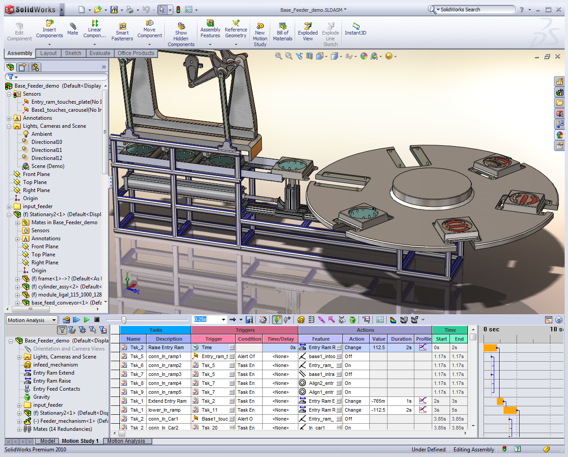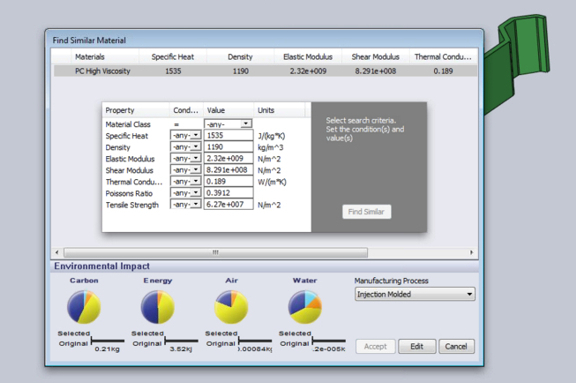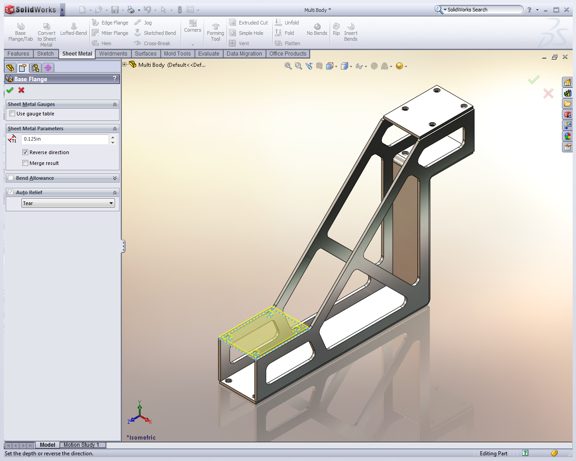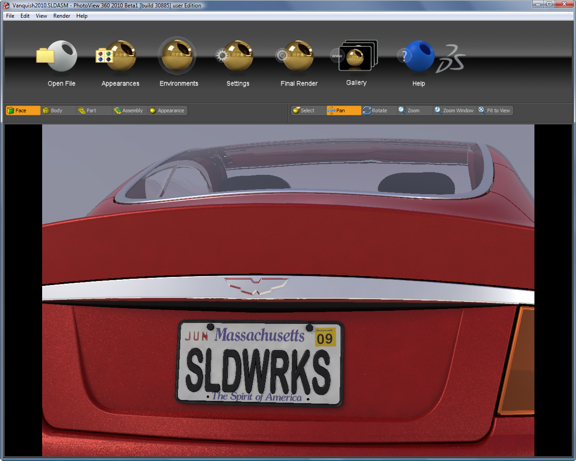Latest News
August 26, 2009

This Monday, the news embargo on SolidWorks (SW) 2010 beta is lifted, allowing testers to openly discuss the features they’ve come across in the early code. But what is arguably the most remarkable enhancement to SW 2010 is already in the public realm. In my view, Sustainability Xpress, first introduced in June and now available as a beta download in SolidWorks Labs, is a pioneering effort among CAD vendors to advocate greener design.
In essence, Sustainability Xpress gives users the ability to see—or foresee—the environmental impact of their design decisions. The plug-in, developed in partnership with PE International, gives you an easy way to predict the carbon emission, energy consumption, air pollution, and water contamination that might result from your choices of material, procurement site, production method, and sales location. (The distance between the production site and where the product will be sold and used, for example, could increase energy consumption because of the transport required.)
If you’re a skeptic of the green design movement, you might still find the software useful for its ability to suggest similar materials. Because Sustainability Xpress comes with a material database, you can use the “find similar” command to locate substitutes with similar density, thermal conductivity, elastic modulus, and tinsel strength.
Rick Chin, director of product innovation at SolidWorks, revealed “cost” is another variable that beta testers have expressed an interest in seeing in upcoming versions of Sustainability Xpress. But because material costs vary widely depending on the region, you won’t likely see this incorporated in the near future. (For more on this, read “Sage Advice on Sustainability,” July 1, 2009.)


From Solid Part to Sheet Metal. Occasionally, you might come across 3D solid parts that you wish you could substitute with sheet-metal parts. But the original part is constructed out of 3D parametric features, not sheet metals, so you’re forced to recreate the part from scratch in sheet metal. In SW 2010, you can convert the solid into a corresponding sheet-metal structure with just a few mouse clicks, then produce the flat pattern, ready for cutting and folding.
The new release supports multibody sheet metal parts, allowing you to create parts comprising sheet metal and weldment parts. In addition, you can use the Mirror Part command in sheet metal environment.
Mirrored Components. This feature lets you select an entire component (for example, the left-hand grip on a bike handle), then instantly create a mirrored counterpart on the opposite side (as the right-hand grip on the same handle bar). The preview, presented as a transparent shade, lets you determine the orientation and placement of the mirrored component. The parametric associations between the original and the mirrored component are preserved, allowing you to edit or simulate them in unison.
Event-Based Simulation. If you’re involved in designing industrial machines, you’ll be pleased to find that SW 2010 offers event-based simulation, a useful feature to study and improve the cycle time of large-scale mechanical assemblies. With this tool, you can lineup a set of events (sensor activation, surface contact, on so on) and the actions they trigger to observe the cycle time of mechanical movements. If needed, you may adjust the speed and rerun the simulation.
Decal and Depth of Field in PhotoView 360. If you’re a consumer good designer, you’ll often come across designs that require a client’s logo to be nested in the surface of a product. With PhotoView 360, part of SW 2010, you can embed a 2D image—or a decal—in your SolidWorks model’s surface, which becomes part of the final rendering output in PhotoView 360. The new version of PhotoView also supports depth of field, so you can create a rendering where objects closer to the virtual camera are in sharp focus but those in the distance are deliberately blurred, creating simulated distance between foreground and background.

Direct Editing. Lately, the resurgence of direct modeling has been capturing much of the headlines. SolidWorks has defended its stance to remain in the parametric camp by pointing out SW has had direct-editing tools for quite some time, bunched together under Instant3D (read “SolidWorks’ Official Stance on Direct Modeling” and “Addendum to Our Direct-Modeling Discussion”). The obvious question is, will we see additional direct-editing tools in SW 2010?
The answer is yes, but only in small increments. The Move Face command is now available directly in the right-click menu when you’re not in any command. You will also be able to execute the same Move Face operations from the Select Connected Faces toolbar.
The Little Things That Make a Difference. In the video clip introducing SW 2010 (at the product’s launch site), Fielder Hiss, SolidWorks VP of product management, said, “In the end, the work in SW 2010 is really going to help the customers become more productive. Productivity comes from little things—the little things they do over and over again.”
That may be the best characterization of the new release itself. The enhancements in SW 2010 are not the groundbreaking, buzz-building type. The company contents the hard work its developers have put in—from making mating operations easier to improving model-rebuilding speed—leads to a “faster, smarter, rock solid” CAD product.
Sustainability Xpress, however, is an exception. In a simple, effective interface, the new plug-in reduces complex and often interconnected green concerns into a series of inputs and graphical feedback. Years later, when making ecologically sound design choices becomes common practice, we may look back at the introduction of Sustainability Xpress as a watershed moment in CAD.
In the next few weeks, I’ll take a closer look at some of the new features in SW 2010, so stay tuned.
For more on Sustainability Xpress, watch the interview with Rick Chin, SolidWorks’ director of product innovation (video from SolidWorks’ YouTube collection).
Subscribe to our FREE magazine, FREE email newsletters or both!
Latest News
About the Author
Kenneth Wong is Digital Engineering’s resident blogger and senior editor. Email him at [email protected] or share your thoughts on this article at digitaleng.news/facebook.
Follow DERelated Topics






